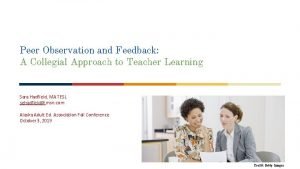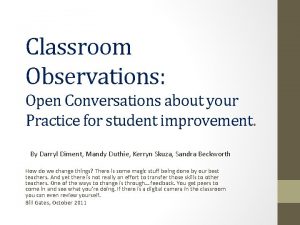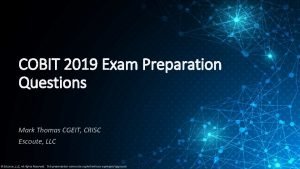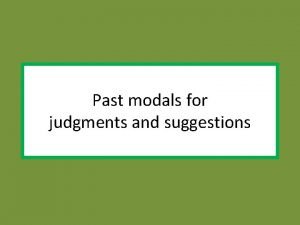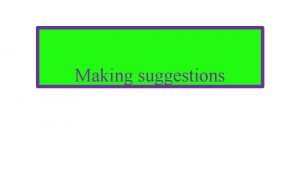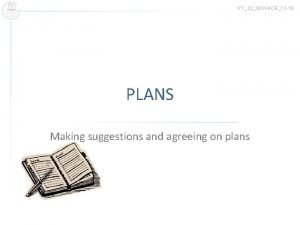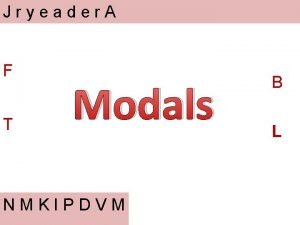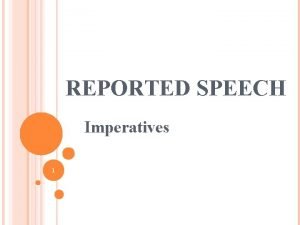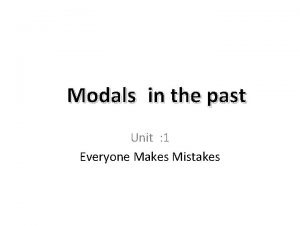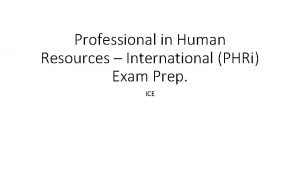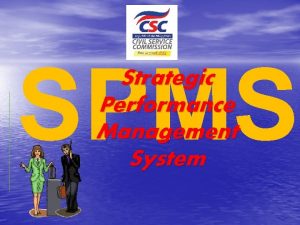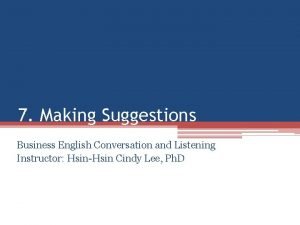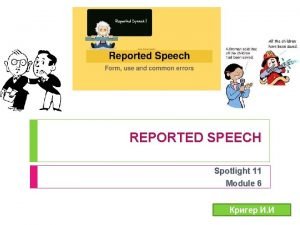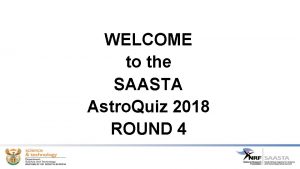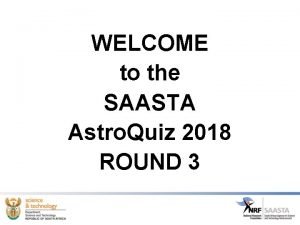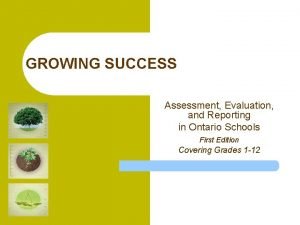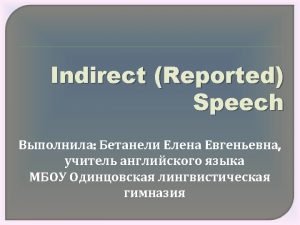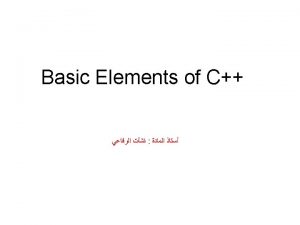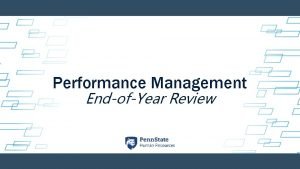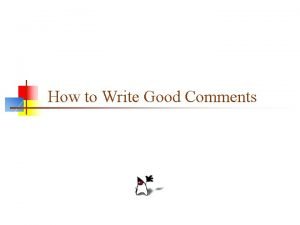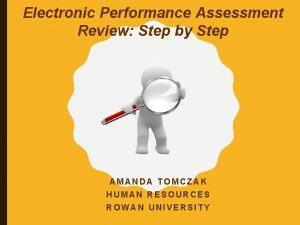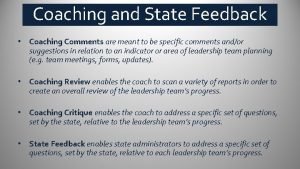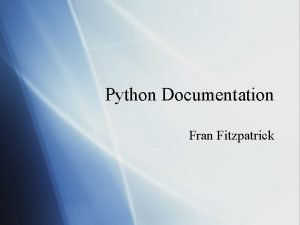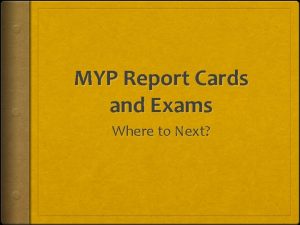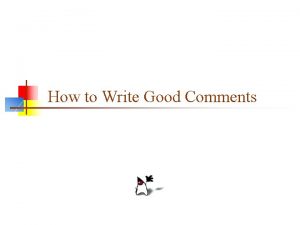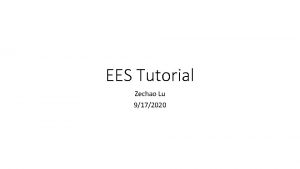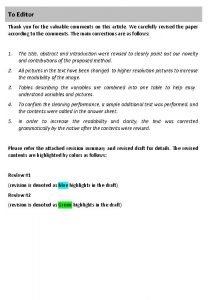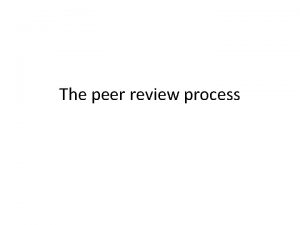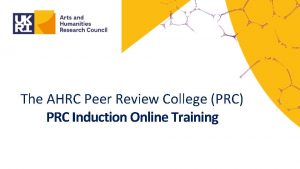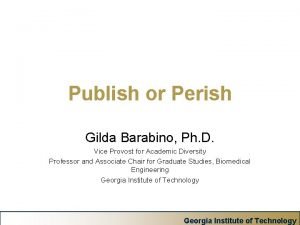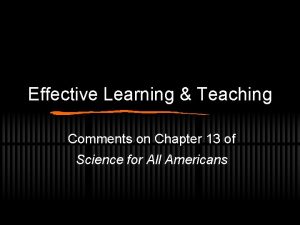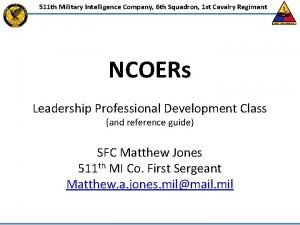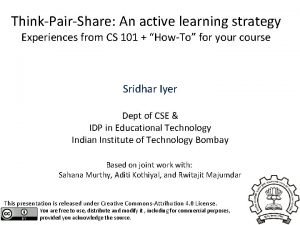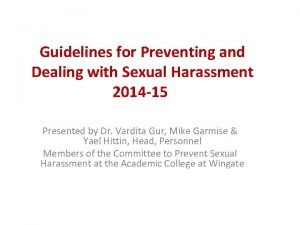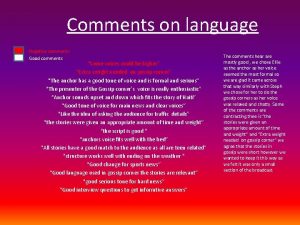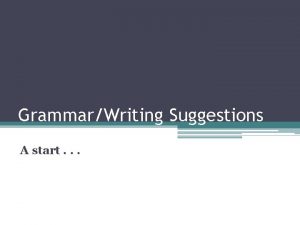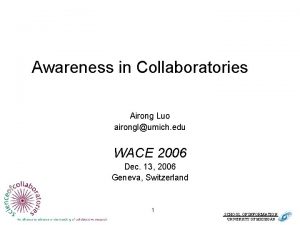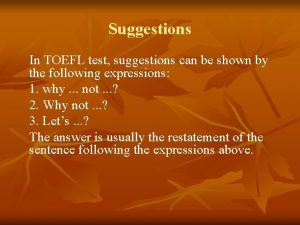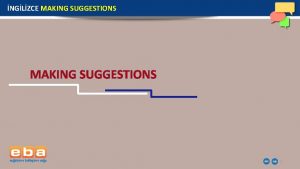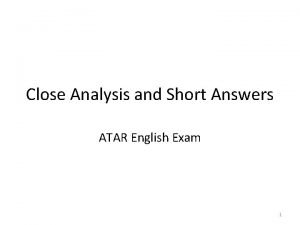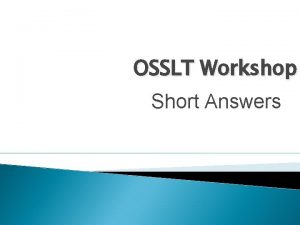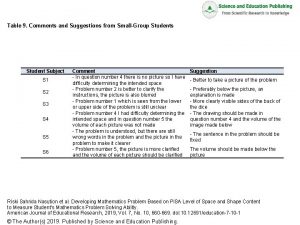2019 WACE Exam Comments and suggestions Short Answers





























































- Slides: 61

2019 WACE Exam Comments and suggestions


Short Answers

Short Answers Make sure you do three. No less, no more! • PART A (2 marks) • Its easy to throw away marks on part (a) – hunt for 2 nd mark • Two clear points (include example) • PART B (3 marks) • Often ask for 3 things – make sure to make 3 clear points • Signpost your answer – use guide words: eg ‘firstly’, ‘secondly’, ‘finally’ • Use Examples! • Don’t WAFFLE – there’s not enough time or space

Short Answers • PART C (5 marks) • Treat it like a ‘mini-essay’. • Define key terms • Show content depth • Make an argument and/or evaluation (don’t be too descriptive). • PAL vocabulary • Examples (essential) • Stance may be necessary Define terms. Stance (if approp). Outline Discussion of first point: Show content knowledge Use PAL vocab Examples essential Discussion of second point Show content knowledge Use PAL vocab Examples essential Tie back. Restate stance

1 a. Outline one source of the powers of the Governor-General in the Commonwealth Constitution. (2 marks) • Constitution – s 61 [vests executive powers with the Queen & her representative, the Governor General] • Executive power lies with the Queen & she delegates this to her representative, the Governor General. • Reserve powers that are exercisable by the Governor General at their own discretion.

1 b. Explain the relationship between the Governor-General and the Federal Executive Council (FEC) as outlined in Section 62 of the Commonwealth Constitution. (3 marks) • s 62 - There shall be a Federal Executive Council to advise the Governor‑General in the government of the Commonwealth, and the members of the Council shall be chosen and summoned by the Governor‑General and sworn as Executive Councillors and shall hold office during his pleasure. • The Governor General is the President of the Federal Executive Council [FEC or EXCO] • Convention binds the GG to ‘act on the advice of the Federal Executive Council’ and so this gives EXCO defacto executive power, that is, it gives Cabinet (that has no recognized power in the Constitution) the power to legally enact its policies.

1 c. Discuss one argument for and one argument against the power of the GG to dismiss a Minister, including a PM. (5 m) • FOR – s 64 refers to the appointment of ministers & requires that they be members of Parliament. This section underlines the principle of responsible government – ministers are elected representatives & are accountable to the Parliament. They hold office ‘at the GG’s pleasure’. • Being independent of the government, they can hold Ministers to account. • In cases where a Minister refuses to resign, this allows the PM to request it. • Eg: 1975 Crisis – the govt became unworkable due to Senate blocking Supply, the GG relied on his reserve powers to sack the PM & his Ministers. • AGAINST – The GG is unelected whereas the PM & Ministers have been elected by the majority will in a representative democracy.


2 a. According to the C/w Constitution, outline in which bodies C/w judicial power is vested. (2 marks) • Judicial power is the power to adjudicate & make legally binding decisions in resolving disputes & interpreting statutes (including the Constitution). • s 71 vests judicial power in a supreme court to be known as the High Court of Australia & other courts that have been created by the C/w parliament • The HCA also has judicial power to hear appeals from any court jurisdiction in Australia – s 73 • The HCA has original jurisdiction as outlined in s 75 & s 76

2 b. Explain the concept of ‘separation of powers’ as it exists in Australia. (3 marks) Theoretically, SOP has ‘power’ split between 3 separate branches of govt [Legislature, Executive, Judicature] such that each are independent of the other, and power is not confined to one branch. • Rejects ‘arbitrary power’ exercised by one branch of govt. • In Australia the extent of the SOP is not as complete as outlined by Montesquieu, due to its origins as a Westminster system where the Executive must sit within the Legislature (s 64). This means that the executive is drawn from & is accountable to the legislature.

2 c. Discuss two features of the separation of powers as it operates in a particular non-Westminster political & legal system. (5 marks) • The US has complete SOP in that each of the Legislature, Executive & Judicature are completely independent of each other. • SOP is outlined in the Constitution – the President is the head of state & the head of govt & can not sit in the Congress. The Pres appoints his executive (Secretaries of State) who must not be in the Congress. If they happen to be elected MHRs/Senators, they must resign from this House to be in the executive branch. • Congress is dominated by political parties & focuses on the legislative process. The President can also introduce legislation but must get a Senator/MHR to do it on his behalf. • The Judicature is independent of the other 2 Arms of govt, however, Justices are appointed by the President with a 2/3 confirmation by the Senate…. so not complete separation.

3 a. Outline the purpose of Standing Orders in the C/w Parliament. (2 marks) • Standing orders are provided for in the Constitution (s 50) and are approved by the relevant chamber – Hof. R and Senate in C/w Parliament and in State parliaments. • Their purposes are to set the rules for how the chambers’ businesses are managed, set rules of questions and debates, determine how legislation is passed, maintain order in the chamber, provide sanctions for breach of standing orders, etc. • Examples include voting on motions, requiring relevance when answer questions (QT), questioning witnesses in committees, etc. • s 94 A – eject members from the Hof. R.

3 b. Explain one way in which the Senate can keep the C/w Parliament accountable. (3 marks) • Focus is C/w Parliament, NOT executive. • Identify what it is that Parliament does that requires accountability (legislation could be a strong focus). • Choose one - Reject bills from the Ho. R through a motion on the floor, scrutinize bills in the chamber and in committee (and make amendments), seek witness testimony in legislative committees, especially the Senate Estimates process, etc. • A specific example would ensure the 3 rd mark.

3 c. Discuss one argument for and one argument against the proposition that ‘elections keep the House of Representatives accountable’. (5 marks) • Requires clear arguments for AND against – this needs to be clearly signposted. Briefly identify purpose of elections and their importance for the Ho. R – principally, the formation of government. • For– performance of individual MP is judged (Briggs-Sharkie; Abbott Steggall), performance of govt (or opposition) and the MPs status within (solidarity), voting system (preferential) provides for protest vote to act as a warning to incumbent MPs, etc. • Against – 2 -party system dominates, voters choose party over candidate, presidential campaigning (Scomo 2019 election), voters ignorant of preference deals resulting in unintended MP election, limited to the calling of an election, etc.

4 a. Outline what is meant by ‘transparent processes’ in the Australian courts. (2 marks) • Define transparent process as courtroom procedure open to public scrutiny. • Identify one-two features of this such as: • public hearings, • court procedure made available in advance, • decisions are public and published (Law reports), • HCA hearings televised online.

4 b. Explain the process for removing Justices from the High Court in Australia. (3 marks) • Justices of the HCA are identified in s 71. • s 72 outlines their removal process – clear formal steps of both houses (must be in the same session) agree there is ‘proven misbehaviour or incapacity’ by the Justice and the GG is informed in. Council. • No such removal has occurred but Lionel Murphy (1986) came close. Students should not discuss any other court.

4 c. Discuss two ways in which the C/w Parliament can hold the courts accountable. (5 marks) • Identify what the courts need to be accountable for – common law, statutory interpretation, judicial processes, behaviour of justices & the way they’re managed, etc. • This question is NOT limited to the HCA and can include recent concerns about the Federal Circuit Court (Street & Vasta) as well as individual federal judges. • Ways include: • endorse common law (Mabo to Native Title Act 1993), • statutes that require reporting (Federal Court Act 1976, Acts Interpretations Act 1901), • removal of Justices (s 72 ibid), • Parliamentary inquiry through commissions (Parliamentary Commission of Inquiry Act 1986).


Source Analysis

Source Analysis • PART A (2 marks) • Drawn from source and may require a definition or brief explanation of a term • Make sure you use the context of the source to guide your answer • As for short answer – Hunt for 2 nd mark • PART B (4 marks) • Will ask for reference to the source ‘in your own words’ • Use signpost words if the question asks for 2 points etc (firstly, secondly) • Quote from the source • Examples beyond the source may illustrate your answer

Source Analysis • PART C (6 marks) and PART D (8 marks) • These are often inspired by the source, rather than a direct quote from the source • Define terms from the question • Show content depth. • Argument and/or evaluation, (don’t be too descriptive). • Rich examples are essential. • Make links to the source – remember it’s a source analysis, not a short answer!



5 a. Outline the purpose of s 128 of the C/w Constitution. (2 marks) • S 128 - provides that any proposed law to alter the Constitution must be passed by an absolute majority in both Houses of the C/w Parliament. If passed by both Houses, it is submitted to a referendum at least 2 - 6 months, after it has been passed by Parliament. In certain circumstances, a proposed amendment can be submitted to a referendum if it is passed on two separate occasions by only one House of the Parliament. • At the Referendum the proposed alteration must be approved by a 'double majority'. That is: • a national majority of electors in the states & territories AND • a majority of electors in a majority of the states (i. e. at least 4/6 states). • The purpose is to ensure that the only formal method of changing the words of the Constitution lies with a vote by the people of Australia, ie, a democratic means of changing this document.

5 b. With reference to Source 1, explain in your own words, two reasons why some referendums fail. (4 marks) • Responses must be put into the student’s own words. • Lack of understanding of the proposed change &/or why it is necessary will result in voters voting NO. “don’t know, vote no idea” • Lack of public education on the proposed change will result in voters voting NO. “politicians often haven’t sold the proposal well” • Lack of bipartisan support will lead to mixed messages. • Lack of trust, especially where the C/w Parliament is concerned & the possibility of them increasing their powers through the proposed change. “No we are actually happy with the powers you’ve got” • Double majority is an extremely high standard to achieve – “In Australia a referendum requires more than 50% of a national vote, and four of the six states also have to vote in favor of the change” • Eg: 1977 simultaneous elections received – 62% of National vote but only 3/6 states, so it failed.

5 c. With reference to two successful referendums in Australia, discuss how each altered the C/w Constitution. (6 marks) • Required sound knowledge of 2 successful referendums & how they altered the Constitution. • 1928 – States debts taken over by the C/w = inclusion of s 105 A • 1946 – Social welfare allowing C/w to expand power = inclusion of s 51 xxiii. A • 1967 – Indigenous changes = deleted s 127 & altered s 51 xxvi so that Aborigines were included in the census • 1977 – casual vacancies in Senate = altered s 15 to ensure the party of the senate position fills the vacancy • 1977 - retirement age of judges = altered s 72 such that justices must retire on their 70 th birthday, prior to this the appointment was ‘for life’.

5 d. Evaluate the impact of referrals of power in bringing about informal change to the C/w Constitution. (8 marks) • Define ‘referral of power’ – s 51 xxxvii enables the C/w Parliament to make laws on matters that the States have ‘referred to them’. • Reasons why States may want to refer a power could be a lack of resources ($) to deal with the matter or a desire to regulate laws across the nation. • Process – State must pass legislation in its parliament to officially refer the power to the C/w. • Eg: The Criminal Code Amendment (Terrorism)Act (2003) – all States referred power to the C/w following the 9/11 terror attack on US. • 1977 – SA & Tas referred powers regarding rural railways, possibly to save $’s • 1986 – all States (except WA) referred power to C/w so the Family Court could hear cases over custody of children from de facto couples as though they were married couples. • 2008 – NSW, Vic, SA, ACT & Qld transferred Water policy to C/w – Murray Darling Basing Management. (s 100)



6 a. Outline what is meant by ‘equality before the law’. (2 marks) Define the term and apply to an example (how provided). Liberal democratic principle of treatment by judicial officers towards those presented before them regardless of a range of demographic features. Consider Racial Discrimination Act, Sex Discrimination Act, etc.

6 b. With reference to Source 2, explain in your own words, two issues associated with the expansion of anti-discrimination law. (4 marks) • Needs to identify and explain two issues, drawn from the source. • Could include: • Expanded not because of evidence or need but whose turn it is; • The application of the laws is questioned as to whether they achieve their original intent; • Not resolving actual issues but enhancing causes/political goals; and • Being used to stifle legitimate political debate.

6 c. Discuss two rights protected by common law in Australia today. (6 marks) • Identify common law’s origins. • Identifies two rights that are based on court rulings and have not since been confirmed, altered or over-turned by statute. • Consider: • ACTV, et al (political expression), Dietrich (fair trial), Timber Creek (native title and cultural practice) • Discussion should include brief statement why they were created and how the C/w or higher courts have not sought to significantly amend or over-turn, thereby reinforcing common law rights. • Students should be aware of which examples are statutory and constitutional and thereby avoid them.

6 d. Evaluate the extent to which specific statutes have impacted the experience of a particular group in Australia in terms of their political & legal rights. (8 marks) • Students should try to examine both ‘political’ and ‘legal’ rights even if one is greater than the other. • Past exam reviews have complained about state-based examples when C/w examples are abundant. • Focus is on statutes, not common or constitutional law. • Students need to determine the extent of change and should therefore start from 1901 and progress to today highlighting key statutes and the changes affected, concluding with the ‘evaluation of extent’.


Essays

ESSAYS INTRODUCTION Introductions count – invest in a good introduction (at least 1/3 of a page): • Define / explain key terms from the question (ALL key terms) • State stance – most questions ask you to assess, or evaluate the validity of a statement (for, against or on one hand, on the other hand) • Avoid weasel words e. g. the statement is ’somewhat true’ • Outline your main ideas – i. e. the main things you’re going to write about. There should be ONE per paragraph. (this is why planning is essential)

ESSAYS MAIN BODY PARAGRAPHS (MBPs) • ONE main idea per paragraph – these should’ve been outlined in introduction • Use the PEEAL format for each MBP: • POINT of the paragraph • EXPLANATION / EVALUATION - Richly detailed content should be included here. Show the depth of what you know • EVIDENCE / EXAMPLES - Use rich examples to illustrate. Knowing examples means you know content – they’re not add-ons • ARGUMENT - should be analytical, thoughtful, related to the topic • LINK - Relate the paragraph to the topic or to the next paragraph.

ESSAYS CONCLUSION Often under-done because of time – don’t throw away these 3 marks • Restate your stance • Give an overview of your paragraph ideas by gathering ideas and evidence into a summary of your argument • Finish well (coda: a final succinct remark).



Question 7 (25 marks) In recent years the Prime Minister’s roles and powers have been too dependent on the Senate of the Commonwealth Parliament. Evaluate this claim. • Recent – Rudd [2009] – Gillard – Rudd – Abbott - Morrison [2019] • Discussion of PM Roles – Head of govt + sets political agenda + advises GG + deals with crisis. • Discussion of PM powers – hire/fire Ministers; chair Cabinet; powers to appoint/remove PS; set election date… • Role of Senate – House of Review; co-equal powers s 53; though convention says Senate can’t pass $ Bills they can frustrate the govt; Senate Estimates & Committees; significant Cross benchers & the need to negotiate with them (Jaqui Lambie). • Issues – consideration of relevant Egs relating to ‘Roles’ & ‘Powers’ • 2019 Scomo relied on Lambie’s support of the repeal of the Medevac laws to get this passed in the Senate. • 2015 - Senator Brandis & Gillian Triggs (HR commissioner), he was censured but PM wasn’t forced to take any action on the matter

• Senate can block/frustrate/delay/introduce legislation • 2016 – 2 pieces of legislation rejected (Clean Energy Finance Corporation & Registered Organisation Commission) • 2016 (Nov) – Senate rejected the SSM Plebiscite Bill • 2016 – Senate & Electoral Reform; sat for 39 hrs; Greens backed the govt to pass thru the Senate • 2017 (Mar) – ALP+Greens+ NXT+Lambie voted together to defeat changes to s 18 C of the RDAct 1975 • 14/2/2019 – Senate passed the Medevac Bill & then it passed the Ho. R whilst the Govt opposed this bill. • Senate can also agree & endorse govt legislation. Eg. 2018 Telecommunications & other Legislations (Assistance & Access) Bill saw the Opposition support the bill. • Decide election date – • Turnbull called a DD in 2016 due to the failure of ABCC & ROC according to s 57. • 2019 – Scomo called election to validate/legitimize his position, he was the underdog but he took control & mounted a strong campaign to win…against the odds. • Appt of senior PS – Abbott dismissed 3 Dept Secretaries, while in 2016 Turnbull appointed Hockey as US Ambassador. 2020 Secretary of DPMC Phil Gaetjins did inquiry into Bridget Mc. Kenzie over the $100 mill Sportsrorts. • Evaluation – has the Senate had a big or small impact on the power of the PM?


Question 8 (25 marks) The High Court of Australia, through its judgments, has had a significant political impact in Australia. Evaluate this claim, making reference to particular judgments of the High Court of Australia. Define – HCA – s 71 vests judicial power in a supreme court to be known as the High Court of Australia… It sits at the apex of the Aust court hierarchy. Jurisdiction – s 73: appellate + s 75: original + s 76: additional original including interpreting the Constitution. Significant – major impacts on Aust society = generally Landmark judgments ‘Political impact’ – those judgments that have affected: • Decisions that impact on federal balance: • Engineers case (Amalgamated Society of Engineers v Adelaide Steamship Co (1920) • Franklin dam (C/w of Aust & Anor v The State of Tas & Ors (1983) • Work Choices (NSW V C/w of Aust; WA v C/w of Aust (2006)

• Decisions that impact on federal balance & financial powers: • Uniform Tax (SA v C/w of Aust (1942) • Ha case (Ha & Ors v NSW; Walter Hammond & Assoc Pty Ltd v NSW (1997) • Decisions made by Executive/Cabinet: • Malaysia Solution invalid (Plaintiff M 70/2011 v Minister for Immigration & Citizenship (2011) • Williams No 1 (2012) = executive; Williams No 2 (2014) = legislation • Validity of Members of Parliament: • S 44 i – Ros Culleton, Barnaby Joyce, Fiona Nash, Larissa Waters, Scot Ludlam, Stuart Roberts


Question 9 (25 marks) Analyse the extent to which collective and individual ministerial responsibility and Senate Estimates have held the Executive accountable in the Australian political and legal system in recent years. • Focus should be on the political executive • There are three methods of accountability in two distinct areas • executive holding itself accountable • IMR and • CMR and • the legislature (Senate) holding the executive accountable. • Students need to outline the function and processes of each of the three and how success would look. • Requires recognition of strengths and weaknesses of the three methods – this provides opportunity for ‘extent’. • Requires examples of successful and unsuccessful (refer to what is achieved by ‘success’) of each of the three from the past 10 years.

• CMR could include resignations by Ministers following leadership spills (plenty to choose from – the mass resignations of ministers when there were the changes b/n Rudd – Gillard – Rudd; those following Turnbull’s overthrow of Abbott & then the fallout from Scomo’s ascension. • Dismissal of Crean due to lack of CMR. • IMR provides a lot of ‘extent’ – Garrett (no resign but responsible), Brandis and Cash (not resign), Fitzgibbon, Joyce and Ley (resigned all due to personal behaviour), Robert (resigned due to financial gain). • Senate Estimates has led to few (3? ) resignations but it shines spotlight on Executive actions and its members’ behaviours. • Student analysis should identify both effective and comparative less effective accountability in all three areas. Analysis should be through clearly ordered evidence (good, unbiased examples)


Question 10 (25 marks) Analyse the extent to which Australia and one other country uphold the democratic principles of popular participation and the rule of law. • Students should identify ‘other’ country as early as possible. • Students need to be clear about what ‘democratic principles’ means and how they are relevant for the categories of ‘popular participation’ (regular elections, voting rights and methods, political association, etc. ) and ‘rule of law’. • Students can choose to answer all categories one country at a time or one category at a time for both countries. It is not seeking a comparison. • Students need to do more than define and explain each feature of the categories. They need to analyse their strengths (upheld) and weaknesses (undermined). • Some features of each category will require more or less analysis than others. Students should place their analysis in order of best evidenced arguments.

• A wide range of Australian examples can be referred to: • Constitution (7 and 24) Electoral Act (free and fair, compulsory voting, etc. ) • Brown v Tasmania (participation and protest), • ACTV et al (participation and speech), • Communist Party (association), etc. can look at upholding popular participation. • Anti-terror and public safety laws, political apathy (evidenced by declining memberships to political parties), partisan politics limits private members bill and ‘delegate representation’ are examples of undermining popular participation. • Australia upholds principles of the Rule of Law, such as appeals and fair trial, through High Court decisions (Plaintiff S 157, Dietrich, etc. ) and through stare decisis but undermines it through access to legal aid and poor education of legal responsibilities and rights (leading to over-representation of some groups).

• For an alternative country, consider the United States. • Popular participation is upheld through free, fair and regular elections, especially of the Ho. R, the Constitution’s amendments (15, 19, 24, 26) and the voting laws of the states, restoration of voting rights former felons. • It is undermined by the voting laws of the states (particularly current felons and poor areas), registration requirements to be a candidate, etc. • The Rule of Law is upheld through right to appeal, constitutional limitations to the executive, constitutional rights (particularly natural justice and due process) through amendments (Miranda – 5 and 6), limit of Supreme Court to create law (Erie Railroad) and stare decisis but undermined by legal costs, racial profiling, election of judges, etc.

MAXIMISING THE EXAM

ENDING WELL • Leave time to read and edit • If you Think and Plan then Write – NO asterisks and arrows!!! (examiners see this as disorganised thinking) • If correcting, no white-out • Write with ‘flow’ • Write dense text – information + evidence + economy (no waffle, no weasel words) • Use rich and relevant examples • Demonstrate deep understanding by linking relevant PAL concepts.

Before the Exam • Have a study plan • Focus on concepts – understand them in context. ‘Joined up thinking’. Linking ideas deepens understanding • Learn examples – good ones can be used for different questions • Practice questions – use textbook activities, • Use 2018 news – what’s been going on? • Other students’ brains? Collaborate – read each other’s work, constructive feedback, learn from peers • Work with your teacher – they are your BEST EVER resource! They want you to succeed as much as you do!


Reading Time Use the 10 minutes wisely • Read BOTH sources first. You can decide which source analysis to do AND you may discover content and examples that may be used elsewhere in the paper • Mentally prepare by selecting your questions, options and planning responses; • Stay calm

‘Marker in Mind’ and a ‘Paper that Pops’ Always keep your marker in mind – make their job easy with… • Good writing • Logical flow • Interesting argument Make your paper pop! • 2019 examples • Connection and links • Maturity Your WACE marker has many papers and works for hours into the night • Make your paper stand out from the pile of papers on their desk

EXAM TECHNIQUES Time budget. Each mark is worth 1. 8 minutes of your time • Short Answer = 18 mins per question • Source Analysis = 36 mins • Essays = 45 mins each Sequence. Up to you – whatever works! • Major thing: Don’t miss anything! Mix it up – take ’brain breaks’ e. g. … • Essay, 2 Short Answers, Source Analysis, other Essay, 3 rd Short Answer

Study Smart and you won’t need any luck!
 Tall+short h
Tall+short h Collegial
Collegial Comments and suggestions for teachers observation
Comments and suggestions for teachers observation Cobit 2019 exam questions
Cobit 2019 exam questions Judge past tense
Judge past tense Asking and making suggestions
Asking and making suggestions Giving advice dialogue
Giving advice dialogue Making plans and suggestions
Making plans and suggestions Past modals for judgments and suggestions
Past modals for judgments and suggestions Making suggestions and recommendations
Making suggestions and recommendations Reported speech form
Reported speech form Perfect modals examples
Perfect modals examples Suggestions and queries
Suggestions and queries Creative arts grade 7 term 2 activities
Creative arts grade 7 term 2 activities Hybrid pitching stance
Hybrid pitching stance Nbme shelf percentiles 2021
Nbme shelf percentiles 2021 Visual communication study design
Visual communication study design Phri exam
Phri exam Strategic function in ipcr
Strategic function in ipcr Phrases for making suggestions
Phrases for making suggestions Reported speech orders
Reported speech orders Making suggestions
Making suggestions Example direct and indirect speech
Example direct and indirect speech Life skills chapter 2
Life skills chapter 2 Astro quiz 2018 answers
Astro quiz 2018 answers Saasta astro quiz 2021 questions and answers
Saasta astro quiz 2021 questions and answers Astro quiz 2019 questions and answers
Astro quiz 2019 questions and answers Astro quiz 2018 answers
Astro quiz 2018 answers Saasta astro quiz 2017 answers
Saasta astro quiz 2017 answers Saasta astro quiz 2017 round 1 answers
Saasta astro quiz 2017 round 1 answers Uc application personal statement
Uc application personal statement Tat meaning in hr
Tat meaning in hr Honest appraisal
Honest appraisal Npqonline
Npqonline Growing success marks
Growing success marks Samples of remarks
Samples of remarks C++ style comments
C++ style comments Housekeeping performance evaluation
Housekeeping performance evaluation Npqh task 2 curriculum-led budget examples
Npqh task 2 curriculum-led budget examples How do you write a good comment?
How do you write a good comment? Ratee comments sample
Ratee comments sample Coaching review comments
Coaching review comments What went well comments
What went well comments Pydoc comments
Pydoc comments What is the result of the following vik null ram
What is the result of the following vik null ram Myp cards
Myp cards Form tutor report comments
Form tutor report comments How to write a comment
How to write a comment Comments in ees
Comments in ees Thank you for valuable comments
Thank you for valuable comments Reviewer comments
Reviewer comments Ahrc grading scale
Ahrc grading scale Reviewer comments
Reviewer comments Reviewer comments
Reviewer comments Good comments
Good comments Comments for chapter 13
Comments for chapter 13 1sg ncoer example
1sg ncoer example Think pair share method
Think pair share method Pyp exhibition timeline
Pyp exhibition timeline Term 2 religion comments
Term 2 religion comments Derogatory comments examples
Derogatory comments examples How does katniss describe the capitol accent
How does katniss describe the capitol accent

